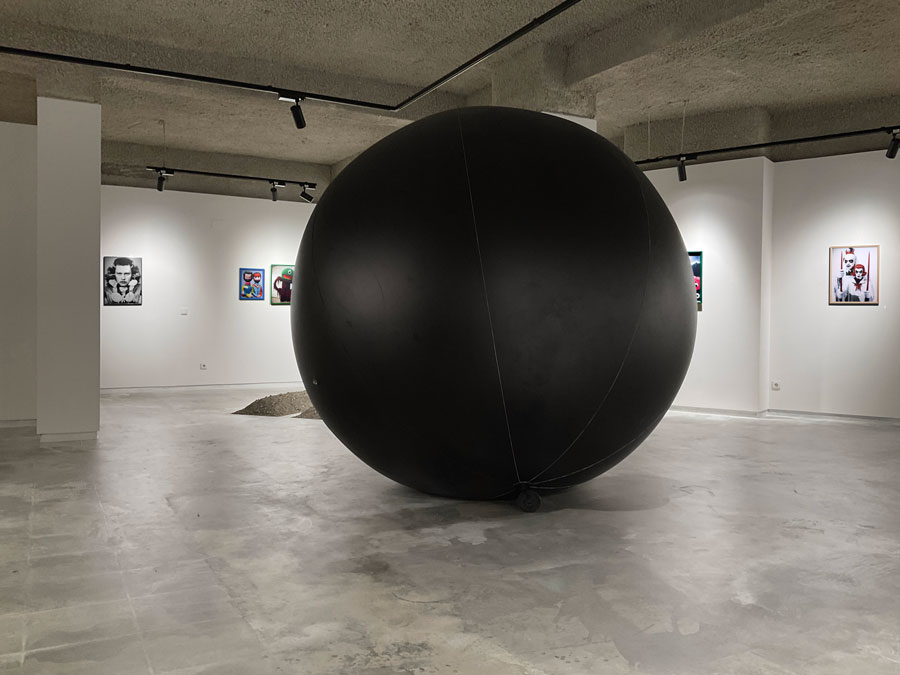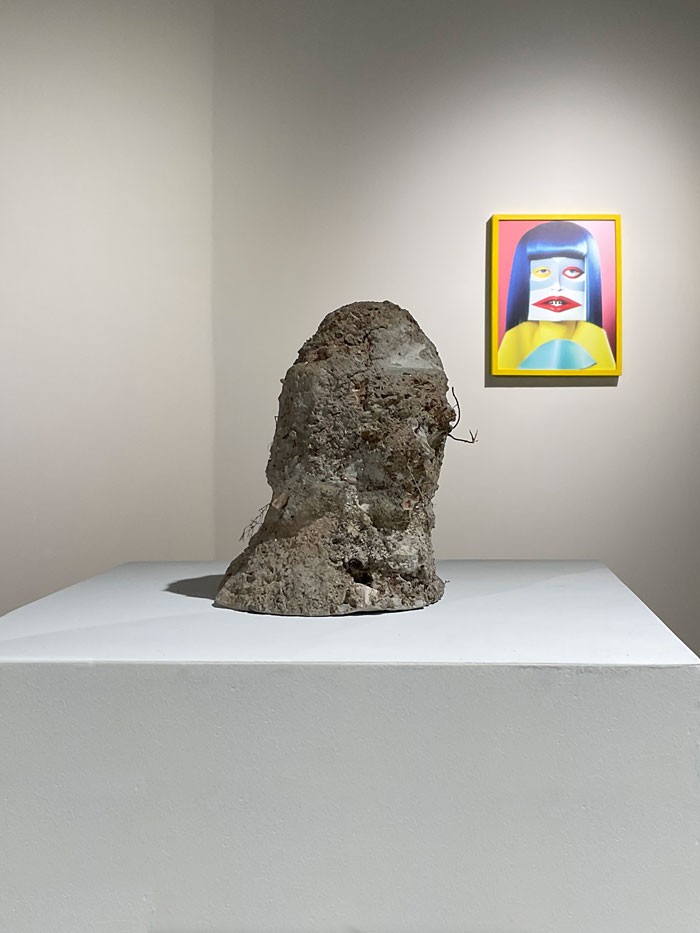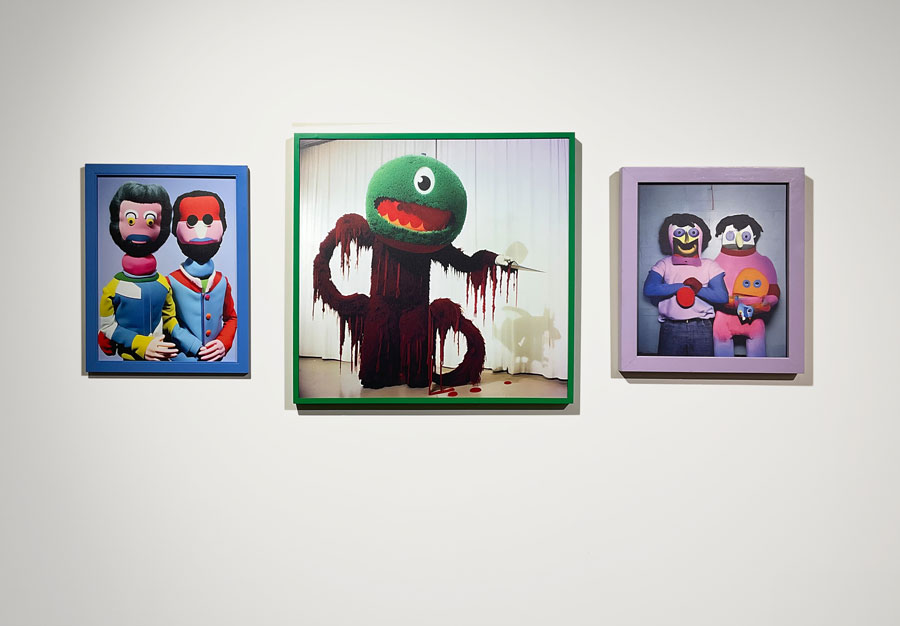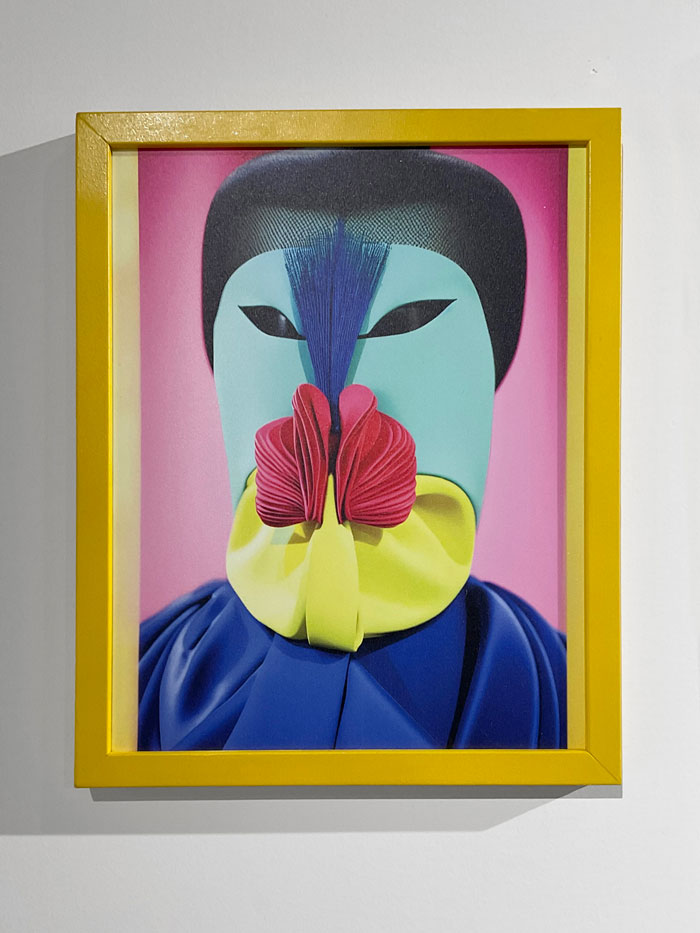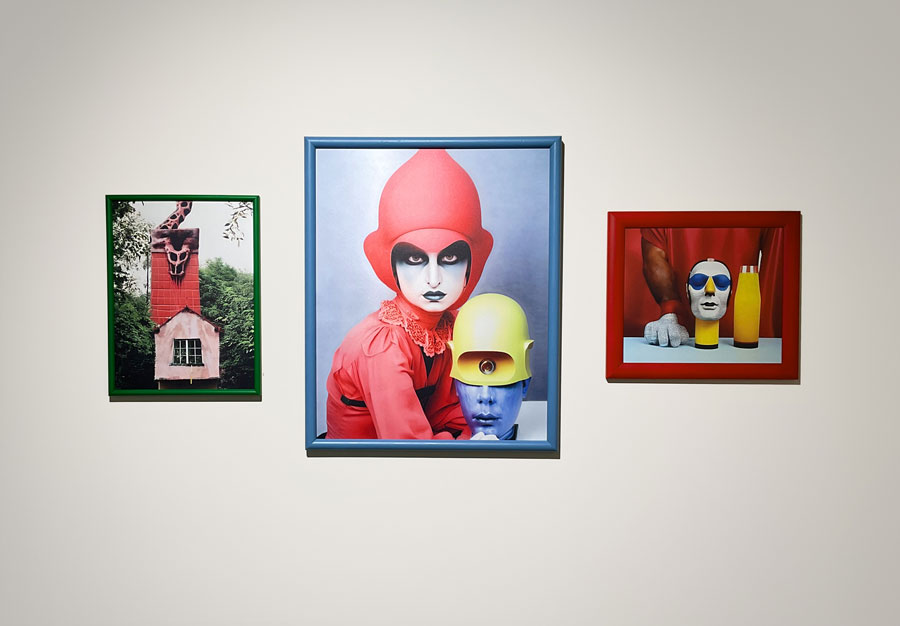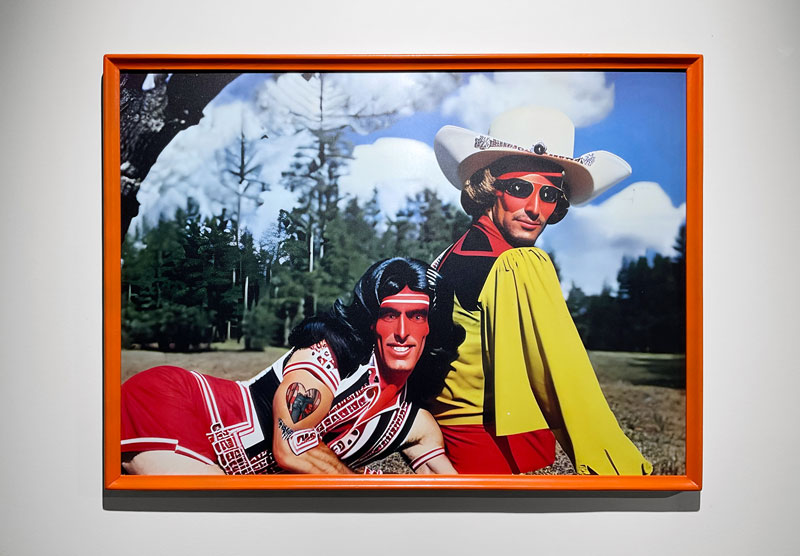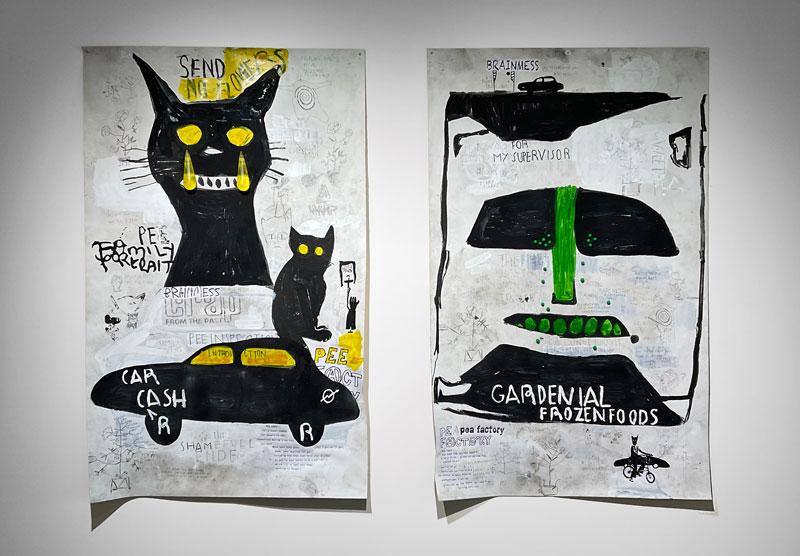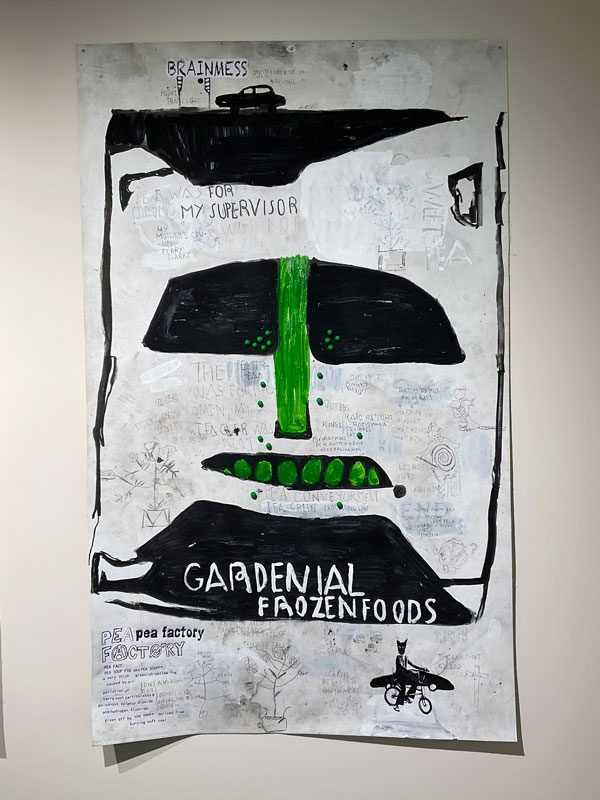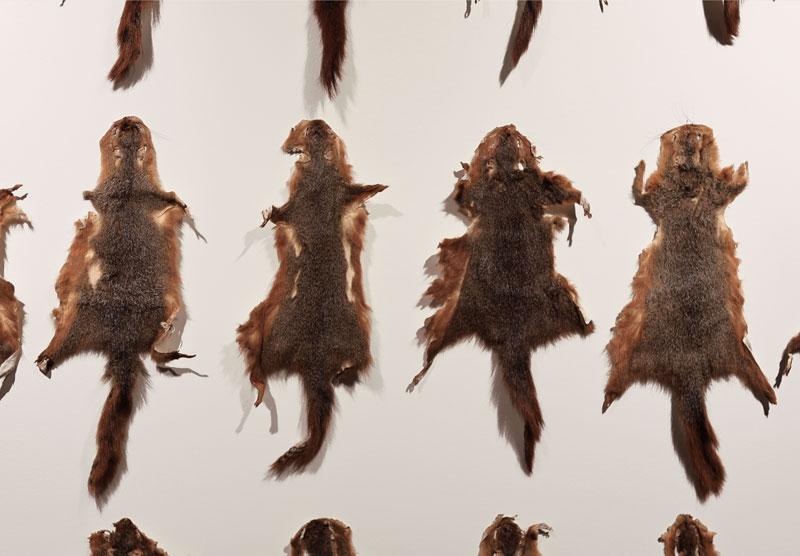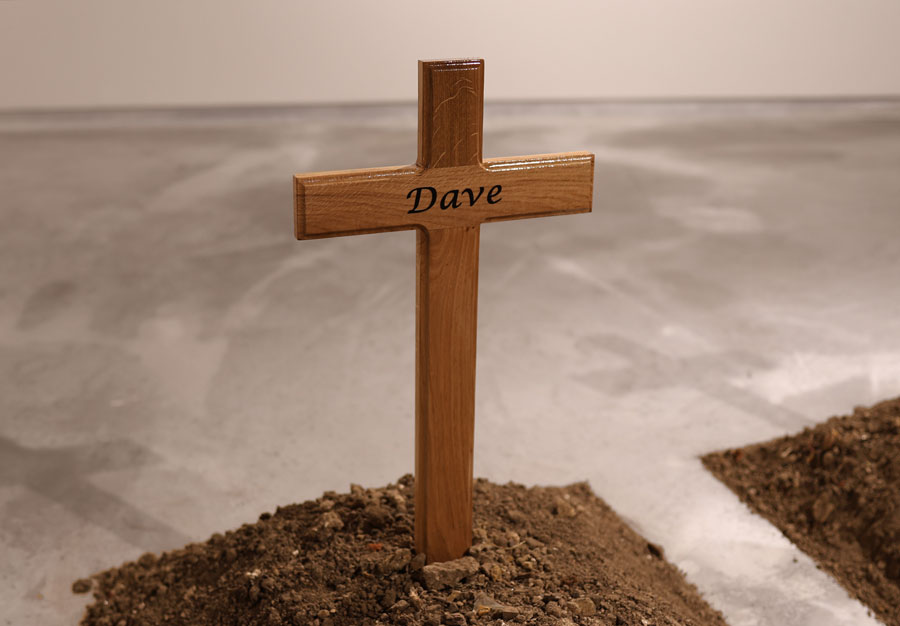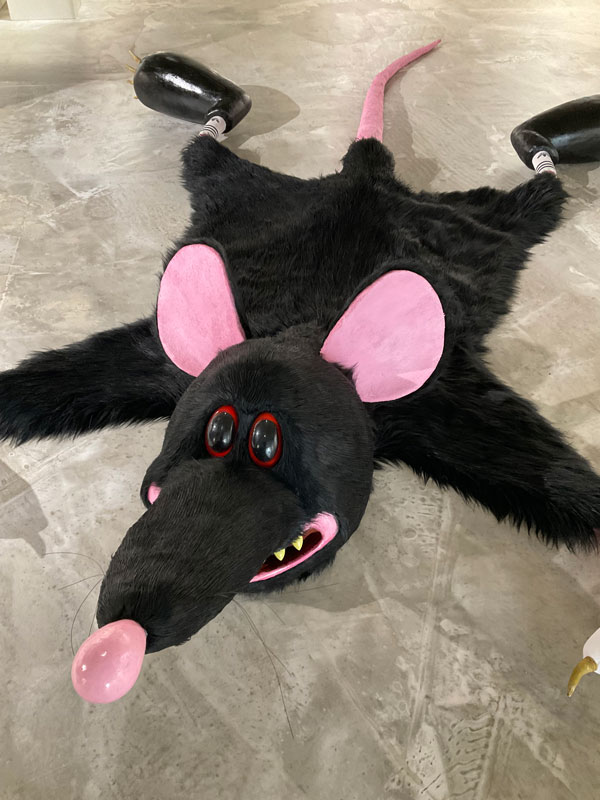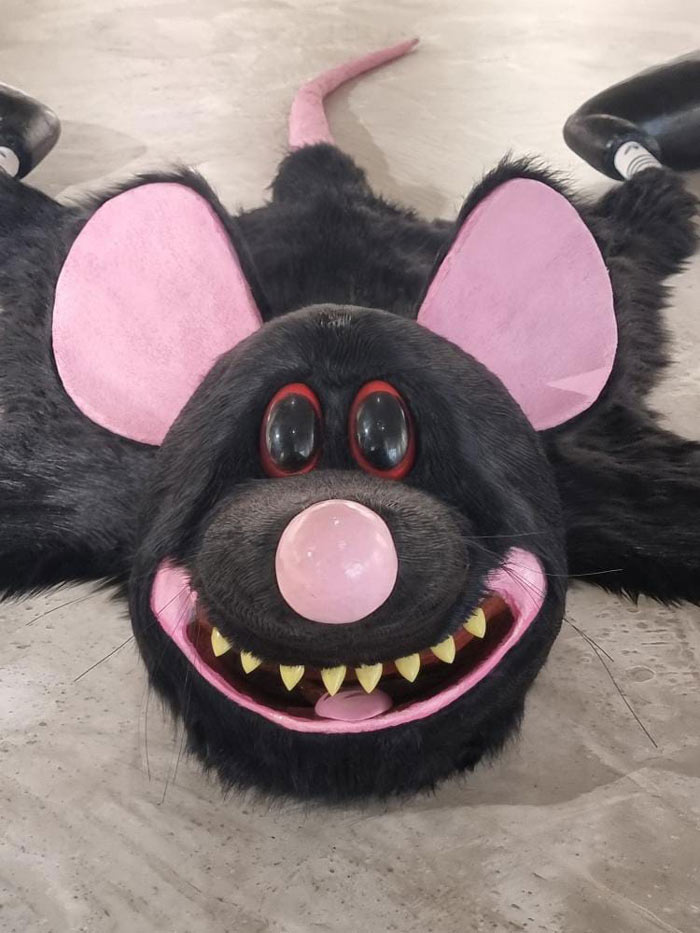|
|
DAVE AND TONY
PEDRO VAZ
Between Berlin, London and Lisbon, DAVE AND TONY create exhibitions that privilege locality, with Lisbon being the city where they produce and exhibit the most. Since 2021, they have participated in six collective exhibitions in the city and organised four solo exhibitions, the last of which took place between 10 and 14 July.
Their latest exhibition, Family Portrait, serves as a starting point for exploring concepts of belonging and exclusion. Born into migrant backgrounds and marked by stories of family dysfunction, Dave and Tony reinvent the idea of ‘family’ through grotesque characters, anthropomorphised animals, and objects laden with irony. ‘The work becomes our family,’ they explain, referring to the works as emotional substitutes for broken ties. Here, squirrels are given individual names, rats become mascots, and improvised graves made of local soil become commentaries on memory and ephemerality.
The plasticity of the media — from inflatables to macabre carpets, from AI to cement sculptures — reflects a rejection of the limits of conventional formats. In Dave and Tony's creative universe, AI, for example, is not seen as a threat, but as a tool to distort realities and challenge expectations, always filtered through their personal archive of absurd references.
Their punk approach does not fit into labels: it is rather a celebration of the dysfunctional, a deliberate escape from reality through the chaotic accumulation of meanings. Between horror and humour, Dave and Tony navigate a territory where nothing is sacred — not even art itself. The result is a work that challenges, disturbs and, paradoxically, invites the viewer to laugh at the darkness.
In a world as disturbing as it is fascinating, where the boundary between horror and entertainment dissolves, the artistic duo Dave and Tony construct their own universe, a space where chaos is raw material and darkness takes on tones of sarcasm and irreverence, always trying to escape reality by producing another.
After the opening of Family Portrait, I had the opportunity to interview the artists, seeking to understand how the cultural context of the city of Lisbon influences the conception of their exhibitions, the duo's creative methodologies, and what future projects they have in mind.
Interview by Pedro Vaz
>>>
Pedro: Given that world is as “unsettling as it is entertaining” as is stated in your website, where do you situate yourselves within this dynamic?
Dave: I think we’re starting to learn to embrace the chaotic, and to use it as a source of inspiration for our work. So, in a way, I think working together, we’ve become less and less frightened of the world, even though it is incredibly unsettling. So, we’re trying now to take a bit more joy from the chaos, even somehow.
Tony: I think, although there are frightening elements, visually, things that might scares some people or things that might induce a little bit of fear or something, even though it looks quite colourful, quite positive, there’s always a very dark element. But at the same time, we’re not afraid of this kind of darkness behind the images. We’ve been working a little to animate some of the images for some of the promotion of the show, and somehow that’s taken the kind of the darkness and turned the darkness into sarcasm, like a twisted kind of message. I think that we mix it all up. I think (in the world) that we are situated somewhere between the horror and the entertainment, like you say. But I think we are immersed in our own work, in our own world, in our home, in our studio. I think there’s always horror. We’re very scarred by family trauma and a lot of things that have happened… like deaths, accidents and so on, like everybody, but I think we try to find lightness in the horror and I think in the world itself as well. We’re trying to put ourselves somewhere, to locate ourselves…
Dave: It’s like we’re looking at things really face on, so to not like, avoid any subject, you know? I think the thing is to to talk about these things directly with regards to our work. I think in some ways you’re often in a position where you have to edit yourself, where you wonder if you’ve gone too far, and I think what we’re trying to do is to actually, sometimes, really step over that line, so that we kind of surprise ourselves in the way that we produce work.
Pedro: And, in your latest exhibition “Family Portrait”, which “family” are you referring to?
Dave: Well, I guess we’re referring to generic and personal families. For example, in one particular work, “Squirrels”, I think most humans would see each single squirrel as a generic squirrel and not really look for differences. But the reason why we gave them all individual names, is because even when we really started looking at them, we realized that each one is unique, obviously - some are fat, some are thin, some have got longer tails... And it was like, wow: these are all individuals, so it’s like, this is a family in some ways, and I guess that comes like a generic family or a metaphor for a family.
Tony: It’s all so taken for granted - that you’re in a kin, you’re in a group, you’re part of a group and you’re perhaps identifiable to a group - identical, but of course everyone is very different. I think we’re now in a country where often the names are like, you know: “Pedro” or “Ines”, inherited names. Inherited, you know, whereas in the UK, say, it’s a little more, I guess, open to naming and, I guess, variety. Like, for us here, we don’t really feel part of any family, I feel like we’re a little bit ostracized, a little bit outside of the Portuguese idea of family, which I think is very much nationalistic, or rather there’s certainly a sort of family patriotism. We don’t understand that. We’ve always been the outsiders…
Dave: My dad is Ukrainian, so I had a Ukrainian Surname as a child. So, even though I grew up in the UK, I never felt fully British. And Tony...
Tony: The same thing. I have an Italian passport, my mother was South African. I left South Africa, went to London which were my most informative years. So, when somebody says “where are you from?”, it’s very hard to answer locationally. I think it’s even more difficult to say where I’m from familiarly. My relationship with my father is not fantastic, my mother’s deceased, Dave’s lost both his parents, we’re ostracized a bit by our own families... So, in a way, these characters (in our work) are a little bit...
Dave: Like stand-ins.
Tony: Like stand-ins. Who might our family be? I mean, we’ve been surrounded by them for the last three months, and I haven’t seen my family for like 10 years. So, I think this becomes our family, our work is our family, our work is our babies. Actually, we have a work there called “Lovechild”. This is our kind of replacement family. And we’re both from quite (Dave perhaps more than me) dysfunctional families as well, you know. I don't want to go into details too deeply, they can be heart breaking, but one example may be finding out that a family member died a year after their death, because no one speaks – discovering things by accident because nobody talks. So, there’s this weird dysfunctionality, you know. My family are all living all over different countries, and we just don’t speak, actually I speak to just one member of my family. So, I think the work becomes our family. So, these are representations of people we would like to have around us. Sometimes they’re unsettling or creepy, but they also represent, I think, our family. The two works that are the most autobiographical are these two drawings “BRAINMESS (PEE FACTORY)” and “BRAINMESS (PEA FACTORY)” cause we’ve been working in a very scruffy, messy way, which kind of mirrors our messy family situations.
Dave: Like, to generate ideas.
Tony: These are very autobiographical. They talk about our pets, and also about our jobs and about our accidents and things that happened in our lives that have made us. And then we have a series of these we’re working more and more and more on really messy drawings. The rat has become our kind of mascot, our “family guy”. We’ve used him in several different manifestations: a small one, one with the motor, one now big rug version, so he’s kind of become kind of our family as well.
Dave: I don’t even know if you’ve answered the question. The question was, “what is the family we’re representing here?”
Tony: Maybe I have answered?
Pedro: I like this idea where you put the works as a family circle by itself. Like, how do you navigate the relationship between the unity of the individual artworks, and the unity of the exhibition as a whole. Like, do they extent to somewhere else that you didn’t expect them to extend?
Dave: Well, I think what happens is that we start with the general idea. This time we were really thinking of, like, a family photo album. Obviously, we’ve both been talking about our families for a bit. Both our mothers, always, every night my mother got the photo album out, like, you know, with the pictures of her father and blah blah, and it was like a constant thing, so that seemed to be like, an idea that we were playing with initially. And then, as we discussed more and more and things spin out, and like we said, we do the drawings and little things start coming in. It just extended to these other things.
Tony: I mean, we’re very open to the accident. Like, for example, the squirrels where we happened upon the pelts, like, quite by accident, and they just sort of clicked though, like: yes, that’s in the show because we have the dead rat rug, and we didn’t actually think it would necessarily fit so well, but actually worked very well.
Dave: Which then also led into the graves.
Tony: So, like I said, death is always in the mix. I think some of the works, like the kind of the more vampiric images like the couple with the candles (“Present Disappointment (Cardius)”) and the little kid there with the Kiss makeup (“S.W.A.L.K”) and the green guy (“I Should Be So Lucky”)... They might have been from the previous show, but they were edited out at some point because they weren’t quite right, for then. So, somehow, some of them grew into this automatically because we still felt that they represented our thought process. I mean, we normally start with a very big body of images and ideas, and it just keeps going smaller and smaller.
Dave: Oddly though, I guess one of the real starting points for the show were these two concrete mounds (“Picket Fence”), and what we start to do is if we ever go away for like, a weekend, we always get a place with a garden, like an AirBnb with a garden, he digs one hole, I dig the other and we fill it with cement, and then three days later we dig it out and becomes like a kind of almost a portrait of us in that place because most likely we will never, ever go back there. And so that kind of - those were also a starting point for this idea.
Tony: Yeah, that was very clear from the start. The inflatables, we love making them, we love working with them. We will have a show in London in September, which we’re very excited about, but that will be another new body of work, and it will mostly be inflatables. So, we have five new inflatables being done.
Dave: And this one, this big black ball (“GAG”), we showed this a few weeks ago, but with a different title, and we plan to use this ball quite regularly in future shows, with different ideas attached to it. So, it becomes like this kind of just a vessel for ideas. Like, the previous time we showed it was called “Opposite Ends (Of The Universe)”, and now it’s called “GAG”. So it will change names - it already had a few little holes that we’ve had to patch. And we think, you know, eventually, maybe in five years, if we showed it enough it’ll be completely covered in patches where it’s had to be repaired. But we kind of like this idea of regenerating this work with different concepts attached to it.
Tony: At some point we changed the location of the exhibition, and we happened upon this space like four weeks ago, when we found out we could use it, so often the space dictates the way it should look, the way it should be. I think the idea of the hanging, initially we have a different hang idea, but then the space dictates to us. Like, in BLOODSUCKER (our previous show), for example, the location was a very tricky one because it was such a crazy space. And how do we address a space that is so raw? But, you know, the work stands on its own first, then the space begins to lead the work in a sense. So, it becomes a happy marriage between the work itself and the location, but we have a fairly clear idea from the start. Our upcoming London show shifts the family into the idea of the cowboy, where its imagery at the moment is still quite similar, but the cowboy begins to take over. Perhaps because we started to watch a little bit of western (which we both hated as kids). But probably because the idea of a cowboy in London means like a dodgy guy. If you get a cowboy builder, it's someone, you know, who fucks up your house, basically. So, the idea of the cowboy, the double play of words, is always very important for us.
Dave: I was talking earlier about going past our limits - we’re tentatively calling the show in London “Shithole”, but meaning it in a positive way. Like, it’s better to have a hole to shit in than not. So, as opposed to how it’s normally used. But we’re a bit worried, like, “oh god, is that going to be like, just too offensive?” So, we’re thinking how we can cross that line.
Tony: It also works historically and with London, in this case with Greatorex Street (the name of the artist run location and the street itself) – in our research, we discovered that Greatorex Street was basically a living sewer, with raw sewage flowing down open gutters and so I guess people just shat on the street. So, it kind of fits into the history of London as well. Like here we’re in Penha de Franc?a. Our friend posted something on Instagram about free soil. He was digging up his garden like two weeks ago, and he posted a picture of this heap of soil, and I was like “well, please, can we have the soil?”, so the soil is from Penha de França, literally around the corner. I think it’s always very important for us to have something that is grounded in the locality. The graves were going to happen but we didn’t know how, and then our friend dug up his garden, and then we took the soil. So, we like this kind of constant. Like, there’s a place, but it becomes very grounded in the place, so I think this is always important to us. We showed one work in Peckham in London last October, and again, it needed to have a bit of a Peckham in it. So, we got a bucket, some things from a local shop in Rye Lane… So, locality is very important to us, although the work itself is might be quite closed, as in tight, conceptually, but with every possibility to open up.
Pedro: Where do you draw the line between the accidental and the AI generated elements, and human design inputs in your creative process?
Tony: I think that OUR input is everything. AI for us is incidental, it’s just another tool.
Dave: Yeah, we’re definitely not scared of AI… (mumbles)…
Pedro: I don’t ask in a judgmental way, I use it as well…
Dave: We’re really not scared of it because, I guess like, in terms of the way any human or anything develops, the new things have always been used by artists. Things like camera obscura, etc, etc, etc, photography blah, blah, blah... So for us it makes sense to use what’s available now.
Tony: Things like AI prompts, if you’re working like this, I think our aim is never just to use it to make a nice image. We try and break it, we want to break the AI, you know? I don’t know if you’ve ever tried to type in it, like all the swear words and see what comes up. It’s like the kid who looks in the dictionary and sees the word fuck, or you know, blowjob, for the first time, and they laugh, you know. It’s this kind of trying to break the safety of the technology. And I think this is where also we have the must fun because, actually, the nice thing about AI is that is fast. Like, it might take us 200 years to do the images we want to do, but like in 10 seconds you can have 200 images.
Dave: Often, we’re using our own archive of stuff. We’ve got a huge archive of images that we’ve produced over the years.
Tony: We collected toys and masks and all sorts of weird-like weird things, like curiosities.
Dave: We’ll often do like, do a little setup and photograph it, and then feed that into AI anyway. So, we’re not really ever just giving the computer the free reign.
Tony: Yeah, I think that what we want to do is to confuse the viewer as to like “What is this image? Did it come from a photoshoot? Is it art directed? Is it from a video? Did the video come first, or the still come first?”. Like, “It is us dressed up?”. Sometimes it is. It’s like, “where are WE in the work?” We’re always in the work, obviously. But it’s like “is that our old house? Was there a giraffe? Is it a snake?” - you know? There’s these questions, like, “what’s going on here exactly?”. We understand and don't understand, sometimes. It's like a paradox situation always.
Dave: We want to be surprised by the images as well, don’t we?
Tony: I mean, of course we have all our references, and words and things, I mean, this wordplay thing is very important to us to mess with. I think we’re just messing around a lot, and then we know like, yes, something is good - like “That’s good, or nope, or that's a good one, that’s a good one…” And we throw away probably 10 times more than we produce.
Dave: And in a way, AI has made us look at the way we work very differently, like, even with these drawings. Like one is called “PEE FACTORY” factory, that’s P double E, and the other one is “PEA FACTORY” – that’s P, E, A. And they’re both from the same kind of stories.
Tony: And they’re both kind of a little bit narrative about similar events in both of our lives, like: Where do we cross? Where is that point of crossing?
Dave: And that kind way is the way we work with AI. We want differences, but sometimes very subtle changes.
Tony: I think, often if you see two images next to each other, they might not make sense. If you see 20 images that all don’t make sense, then they start to make sense. That’s how it is in our heads. “Fine, we have all this stuff”, and we’re starting to do an edit. It's like “well, what happens if we move this and this?”. And we'll be like “oh well, what's the narrative?”. It's like “fuck the narrative”, we move it across and then it's different... So, we’re liking kind of building this thing. Although we have a fixed theme, I guess, we’re always trying to rebuild it and re-identify it. So, if we had to show this exact show in another space there would have to be changes.
Pedro: And among this whole universe where you have: animals, multiform humanoids, self-depictions in a lot of ways, where does reality reside?
Tony: As soon as something is there, it’s reality. As soon as something is here, it’s reality, it’s already existing, in our existence. So, if whether it’s an image or something we found in the street, as soon as it’s in our vision or our grasp, whatever, it’s part of reality.
Dave: I think the thing is, I would say for myself, I try to avoid reality as much as possible, to be honest. It’s like, when I’m most happy is when I’m in an unreal situation, I guess.
Tony: I don't really want reality, you know? I think my life is about avoiding reality. Actually, I think this is our drive, because reality has a tendency towards...
Dave: Mundanity.
Tony: Conservativism, I guess. But, I mean, everything is real. It’s if it as soon it materializes in our time and space, it’s real.
Dave: And in a way, with the work we make, what we’re trying to do is create things that we can't really find in reality. It’s like giving us some sort of pleasure in creating this thing that isn’t just available in the real world.
Tony: I mean we both always wanted things like any kid, but things were not forthcoming. We both remember as kids saying to our mums “Oh, I want that”, you know, and we would always get the not-good version of that thing. The shit version.
Dave: My parents they had really nothing particularly interesting in their house, it was very like working class functional stuff. And then I would go to the little town museum and I’d be like “wow, all this amazing stuff, there is actually stuff I want”.
Tony: And I think if you ever entered our (present) home life, it’s like a crazy version of this wanting. Our home is like just full of objects, and we love objects, and it might be an expensive object but then there’s a plastic object, and a small and a big, you know? So, our house is becoming more and more like our reality. If people come over and they’re like “oh my god, you guys are crazy”, so I guess we’re becoming more and more crazy, actually. Which is us, moving further and further away from reality.
Pedro: As your work spans installations, stickers, T-shirts, mats, inflatables, sculptures, and even warning signs, how do you approach the concept of plasticity in such diverse mediums? There are so many mediums and so many plasticity, like, how do you feel this?
Dave: Well, carrying on from what we were saying before, I guess we’ve got like such a huge collection of materials of things we’ve found, like, on the streets or in bins, whatever. I think our approach to materials is: if we have an idea, we find a way of creating that idea, and we don’t really have any limits about what we will use.
Tony: Specially it started really in Berlin. I mean, we’re always been to markets, like Deptford Market where we lived in Deptford, was amazing for finding things we needed and wanted, and ornaments and old books and old photographs, really lovely things. We found amazing things for very cheap. We moved to Berlin, and in Berlin we started finding clothing that was dumped and my background was fashion, so we found, like, a Katherine Hamnett shirt, we found Christhian Louboutin shoes that somebody threw out of a car, and they were broken but we fixed them. And then we started to find things like rope, and buckets, and chains, and we started to take all these things in…
Dave: And when people dumped an old sofa, and we would carry a knife around, and we would cut the materials.
Tony: For example, underneath the belly of the rat (“Rat Rug”), the substance inside is all from found felt. We found the blue felt that it was cut off from the Lisboa “book thing” [Feira do Livro] three years ago. We took, like, these big pieces of felt, and we just folded them up. The pink felt underbelly was made from felt found outside the bins in Sao Bento, near 3 +1 (the gallery)…
Dave: Probably discarded from Evy Jokhova’s recent show.
Tony: Yes, she had a pink floor which they just threw away, so we rolled it up and took it away. We have boxes and boxes and boxes of materials like this: from rubber, to carpet, to leather... I mean, literally it’s a mess, like, wires and wires... so, this is all stuff we want to incorporate at some point. I think it will outlive us, we won’t have enough time…
Dave: With the rat there’s a lot of different materials like epoxy resin and blah blah... For me personally, I love using materials and finding different ways of making the material a bit different by adding, say, concrete powder into it, or different pigments.
Tony: I think the materialism of plasticity, like, where does it go in? I think being now in Lisbon, seeing the way people work... Like, I see that people like “bodies of work”, so they’ll do like ceramic and will be a ceramic show, or it’ll be like one certain type of painting... We just don’t think like this. Like, if we could bring a car in here, we would bring a car in. Like, whatever’s the next thing that makes sense. Like, we really want to make some ceramics, but we don’t want to make kind of Portuguese style of ceramics, we want to make really delicate porcelain things and we have a lot of ideas for this. If we could make that happen, we'll make that happen. It’s a matter of time before we find the right place who can help this to manifest. We’ve recently made a small film, where we both dress up…
Dave: And for another show we’re thinking of, we haven't even got any plans for it yet we’ve already started collecting bottles, different sorts of bottles, and this is already starting to germinate an idea for us.
Tony: I mean, the only problem there is storage.
Dave: Like, the inflatables are a great solution to make it work, because obviously they fold completely flat, virtually. So, you know, you get something like this, and it's quite big, but when it's deflated we can store it, at least.
Tony: But I think, in terms of thinking plastically, yeah, for us every medium is possible.
Dave: Everything goes.
Tony: We like the idea of bringing the soil into the space. Maybe like, Land art, art Povera. So, I think just bringing some soil into a beautiful space like this...
Dave: There are no limits.
Tony: The materials will grow and grow and grow, they’re certainly not going to get less, and we’re not going to focus on just image. And I think this is part of creating the chaos, the unreality that we want, like moving further and further away from reality, by just crowding in more and more possibilities, because everything then is a possibility. And I think this is where we’re at, at the minute. Perhaps one day we might do a show with just one thing, that might be really nice.
Dave: I think the problem is, as well - because when we’re discussing, often disagreeing - although it’s cohesive here, but there's been like multiple giant rows, arguments, between us about what should go in and what shouldn’t. And so actually, what that does is that pushes ability to use different things, doesn’t it?
Pedro: You were talking earlier about this thing that is very felt in Portugal, specially nowadays, where this “fascist era ghost” stills haunt the way art is distributed, and made, and exhibited as well. And you push the boundaries to the other way, to erase this old style way of thinking. But, you know, as always, we have to go the other way around to seek what we’re looking for. But, besides this “fascist ghost”, is Lisbon “Punk” enough for what you’re seeking for?
Dave: We find it a little bit frustrating that we still can’t seem to get Portuguese people to our exhibitions.
Tony: There seems to be an active resistance to change, here.
Dave: But what we’ve decided to do is not to care. We love Lisbon, but we’ll sidestep that a bit, and actually we will seek out where we think the work will be seen the best, and be most appreciated.
Tony: I think showing in London is our first creative step away from Lisbon. Also, it’s a sort of homecoming, since Dave hasn’t had a show in London for a long time, when he was working as Dave. But I think London will be the first time like – although we already had a piece in a group show in London – it’ll be the first time we see old friends, so to speak, but in a work context where people see what we’ve been doing for the last X amount of years, so will be like a homecoming. I think there are places that we could now show work, which might be punker than Lisbon. I think there’s a place for Punk everywhere, like, mentality wise. Certainly, I think here (Lisbon) there are enough people who want to a kind of rock ‘n’ roll, you know, like in a sense. I think Lisbon is a good place to show, but the problem is we now need the support of a network where we can sell work, you know? I think if it’s not going to be here, it will be elsewhere. Like now we’re looking at some residencies, possibly, that aren’t in Lisbon or Portugal. We’re looking at showing maybe hopefully in the US next year. Maybe if we can figure something out and then, like, you know, there are many other markets - we need to see where we fit.
Dave: It’s shame, in a way, (that we are not embraced here) because we really love showing work where we live. And, like we said, in a way, our locality is very important for us.
Tony: I think we’re at the point where something needs to give in order for us to feel fulfilled. Like I’ve said, we’re outsiders, we like the idea of being outsiders, we will never be the mainstream. But we need people to start noticing us, like “okay, they’re doing this stuff, good stuff, and perhaps there is a Punk scene”, because maybe there just isn’t a Punk scene, but maybe we’re it, you know? You don’t have to be like, “crazy” to see a show like this or like our previous one, and it can be in Lisbon, it can be in London. The thing is, if this was in London, it would be full of people coming in and out. This is where the Punk scene stops, because there’s not enough support of the underground, or at least the undercurrent… Berlin was the opposite, it was so much underground that if you didn’t fit the cliche punk or the cliche queer, or dyke lesbian, or the cliche immigrant or something... you couldn’t belong in that because you weren’t enough “that”. And in London a little bit the same, you’ve got to dress a certain way, you’ve got to look like the Queen Mother or like somebody from the 30s, or like Grayson Perry. You’ve got to have, like, an extreme character yourself to fit in. I think we will always be the outsider, wherever we are. And where does the outside fit?
Dave: We don’t really see ourselves as Punk. We’re in our own reality. We kind of feel like “that’s just Dave and Tony…”.
Tony: I think people just think we’re weirdos. Like, I think all our friends think we’re weirdos, and like us because we’re weirdos, but they don’t get us. But we also don’t want them to get us.
Dave: And apart from the art scene, from having our three dogs, like, the punkest people we know in Lisbon are the little old ladies who stop us like 20 times a day to talk to the dogs.
Tony: There is a place here, of course, there is a place for everything, but I think people need to, like, just a little bit open up and see that there’s stuff going on. People get a little bit lazy everywhere, but there’s stuff! If you want to look, there’s stuff.
Dave: But I do think that Lisbon art scene is a little bit “vanilla”, you could do with spicing up somehow. Here, the same customer who doesn’t go somewhere because it’s raining, also doesn’t come because it’s not raining…
:::
Pedro Vaz has been organising exhibitions and performances in Coimbra since 2014. Between 2013 and 2018, he completed his Bachelor's and Master's degrees in Artistic Studies at the Faculty of Arts of the University of Coimbra. He is currently pursuing a PhD in Arts and Mediation at the Faculty of Arts and Social Sciences of NOVA University, and works as an independent curator for the Gambuzino Collective, which he founded with Emanuela Boccia in 2023.















